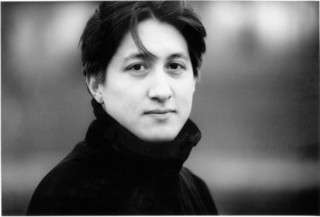|
Back
Exquisite Schumann, Exuberant Beethoven Hong Kong
Hong Kong City Hall, Concert Hall
10/10/2009 -
Toru Takemitsu: Three Film Scores
Robert Schumann: Piano Concerto in A minor, Op. 54
Ludwig van Beethoven: Symphony No.6 in F major, Op. 68 ‘Pastorale’
Freddy Kempf (piano)
Hong Kong Sinfonietta, Junichi Hirokami (Conductor)

F. Kempf (© Monique Deul)
The Hong Kong Sinfonietta continued its Beethoven cycle on Saturday by inviting Japanese conductor Junichi Hirokami for Beethoven’s ‘Pastorale’. To open the concert, he chose his compatriot, the leading Japanese composer Takemitsu’s three pieces of film music, a set that is frequently performed in concert by different conductors and orchestras. Mr. Hirokami’s ebullience was realized by the orchestra’s exaggerating gradations of dynamics and hard-edged phrasings. He also established an intimate communication and collaboration with the players. But what was most annoying was his audible breathes and humming, which sounded disturbing even when I was sitting at row 16.
Freddy Kempf’s transcendental virtuosity on the keyboard has been recognized through his extensive recordings of wide range repertoire with the BIS Records. These include Chopin’s complete Etudes, Liszt’s 12 Etudes d'execution transcendante, various Beethoven’s and Rachmaninov’s Sonatas, and J.S. Bach’s keyboard works, just to name a few. In the concert, the young pianist fully deployed his wealth of exquisite musicality and technical adeptness.
Under his nimble fingers, the piano was personified as an infinitely expressive and delicate instrument. Rarely a note went by without Mr. Kempf bringing plush and transparent intonation from the piano keys. This is intimately compatible with the orchestra’s chamber-scale sound and polished phrases. The light-hearted second movement tellingly exemplified Mr. Kempf’s exquisiteness of phrasing and refinement of articulation. The minimal pedaling and flowing tempo gave the main theme extra sense of innocence and elegance. The scurrying runs in the last movement were also rendered with utmost buoyancy and frothiness.
But the price he paid was the underpowered tension. From the first chord of the Concerto to the vehement coda at the end, Mr. Kempf showed little interest in bringing the music’s passion and sparkle to the surface. For ears attuned to more ebullient and dazzling interpretations of this work, such as those by ‘Golden Age’ pianists like Novaes and Gieseking, Kempf’s reading sounded a little understated.
For encore, he chose one of the most delicate Etudes by Chopin, the Etude in A flat major, Op. 25, No. 1. The textual transparency and tonal buoyancy once again displayed Mr. Kempf’s innate poetry to Chopin’s music.
After the intermission, the Sinfonietta delivered Beethoven’s Pastorale Symphony as part of their Beethoven cycle. Conductor Hirokami’s fluent and metronomic pace throughout, particularly in the first movement, gave the five movement masterpiece a strong sense of coherence. Under his hands (he conducted without a baton for most of the time), Beethoven’s rhythmic impetus never ceased. Like the opening Film Scores by Takemitsu, Mr. Hirokami conducted this Symphony with an ebullient temperament. The Andante second movement was a lively and exuberant account. The incessantly flowing tempo set vivid contrast to the rhythmically volatile bird chirps near the end, making these ‘short phrases’ exceptionally outstanding and memorable. The woodwind solos in the third and last movements were also played with a nice balance and polished phrasing. However, Mr. Hirokami’s approach would have sounded better for a large orchestra. For a small ensemble like the Sinfonietta, that is unable to produce the grandeur and variety of intonations, the rigid pace sometimes led to boredom. Perhaps a more detailed treatment rather than grand contrasts between large sections would have been more welcomed.
This concert was recorded and will be broadcasted by the Radio Television Hong Kong on October 30 and November 5, at 8pm and 2pm respectively.
RTHK’s Website
Danny Kim-Nam Hui
|